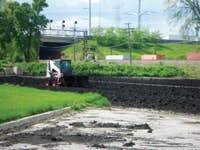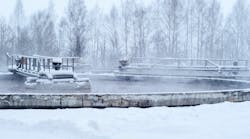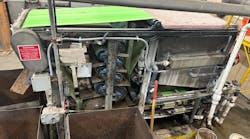The Downers Grove Sanitary District is an 11-million-gal-per-day wastewater utility located in south central DuPage County, Ill. The district serves primarily residential and commercial customers, with a small mix of industrial customers.
The district’s biosolids program has been a model of stability in both cost and production for more than 30 years. Class A biosolids are produced using simple methods, allowing all biosolids to be given away as a useful soil supplement at a dependably low cost to the district.
Primary and waste-activated sludge (WAS) are anaerobically digested, each in its own dedicated digester train. Following digestion, WAS is dewatered on a belt filter press, while primary sludge is dewatered on gravity sludge-drying beds. Following dewatering, sludge is stockpiled outdoors in one of a variety of areas, including a concrete bin and sludge-drying beds dedicated for storage. Stockpiled sludge is aged for three years and is turned over several times during that period when stockpile locations are rearranged around the plant site.
Following three years of freeze-thaw cycles, biosolids are stable and readily dried to a high solids content (greater than 50%) as they are spread out about 4 in. thick on an asphalt pad and bored periodically over a three- to four-day dry-weather period. Following this final drying step, biosolids are pulverized through a trommel screen to give the final product a look of finished black dirt, although it is less dense than dirt and has a slight odor of ammonia.
The district has residential neighbors in the area below prevailing winds. While the plant has received occasional odor complaints in the past, these have been associated with headworks and now-abandoned aerobic digestion operations. Biosolids operations are carefully timed and conducted with consideration to the neighboring subdivision.
The final product is publicly distributed in bulk. The district has a 3-cu-yd wheel loader, a 5-ton dump truck and a 10-ton dump truck for handling and delivering biosolids. A giveaway station located near the plant is stocked with biosolids available for anyone to take for their own use. District contractors are encouraged to use biosolids for construction restoration. Other recipients include park districts, developers, cemeteries and the State Toll Highway Authority.
Sustainable Savings
The best product marketing is via networking and word of mouth. The district advertises the product several times each year in the local newspaper and includes a brochure in one sewer bill per year for each customer. The district offers its sewer customers a once-per-year $5 sewer bill credit if they take delivery of at least 3 cu yd of biosolids in that year. Biosolids also are prominently featured at the district’s annual open house.
Feedback from final users generally is positive. The program is advertised as a “green” way to keep the costs of the local wastewater utility under control. Most negative feedback received is associated with the ammonia odor of the product, which typically dissipates more quickly than that of commercial fertilizers. There are times when customers have difficulty envisioning how much material is in a 3-cu-yd load, but delivery personnel are sensitive to this concern and readily accommodate customers whenever practical.
Quality assurance and control of the product is carefully regulated. The district’s industrial pretreatment program includes revisiting the derivation of all local limits for its industrial users on a five-year cycle. The derivation includes ensuring that limits on industrial customers are low enough to prevent contamination of the biosolids. The pretreatment program requires that the biosolids be sampled and analyzed on an annual basis for priority pollutants and the submittal of a comprehensive report on pretreatment program activities each year.
Sludge Permit
The district also carries a “sludge” permit issued by the state regulating the disposal of biosolids. This permit requires routine monitoring and annual reporting for numerous parameters, including:
- • Metals;
- • Volatile solids (VS) destruction;
- • Fecal coliform;
- • Salmonella;
- • Helminth ova; and
- • Enterovirus.
The annual report also includes the following items:
- • Biosolids management plan;
- • Biosolids handbook;
- • Questionnaire/information sheet;
- • Certification of pathogen and vector attraction reduction;
- • Digester operating data (temperature, residence time, VS reduction);
- • Sludge sampling protocol; and
- • Salmonella lab procedure.
All biosolids recipients are given a biosolids handbook that contains instructions on how to handle and use the material, as well as the latest chemical analysis data. Recipients of larger loads are asked to complete and return a questionnaire detailing how they used the product.
The current cost of the program, including labor, equipment and facility depreciation, fuel, chemical and other operation and maintenance costs, is roughly $0.033 per gallon of digested sludge. This is considered competitive in the local commercial sludge hauling and disposal market.
Two keys to the success of the program are having adequate plant space to stockpile three years’ worth of material, and long residence time (50 days is typical) in the anaerobic digesters to ensure a relatively stable sludge going to stockpile.
Download: Here


